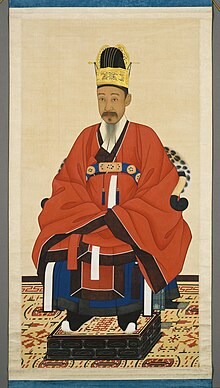Daewongun
| Yi Ha-eung 이하응 |
|
|---|---|
| Grand Internal Prince Heungseon 흥선대원군 |
|
 |
|
| Regent of Korea | |
| Regency | 13 December 1863 – 31 October 1873 with Queen Sinjeong |
| Predecessor | Cheoljong of Joseon |
| Successor | Empress Myeongseong |
| Born | 21 December 1820 Hanseong, Kingdom of Joseon |
| Died |
22 February 1898 (aged 77) Seongjeosibli, Korean Empire |
| Spouse | Grand Internal Princess Consort Sunmok |
| Issue |
Prince Imperial Heungchin Emperor Gojong of Korea |
| Dynasty | House of Yi |
| Father | Yi Gu, Prince Namyeon |
| Mother | Princess Consort Min |
| Heungseon Daewongun | |
| Hangul | 흥선대원군 |
|---|---|
| Hanja | 興宣大院君 |
| Revised Romanization | Heungseon Daewongun |
| McCune–Reischauer | Hŭngsŏn Taewŏn'gun |
| Pen name | |
| Hangul | 석파 |
| Hanja | 石坡 |
| Revised Romanization | Seokpa |
| McCune–Reischauer | Sŏkp'a |
| Birth name | |
| Hangul | 이하응 |
| Hanja | 李昰應 |
| Revised Romanization | Yi Ha-eung |
| McCune–Reischauer | Yi Ha-ŭng |
| Courtesy name | |
| Hangul | 시백 |
| Hanja | 時伯 |
| Revised Romanization | Sibaek |
| McCune–Reischauer | Sibaek |
Heungseon Daewongun (흥선대원군, 興宣大院君, 21 December 1820 – 22 February 1898), also known as the Daewongun (대원군, 大院君), Guktaegong (국태공, 國太公, "The Great Archduke") or formally Heungseon Heonui Daewonwang (흥선헌의대원왕, 興宣獻懿大院王) and also known to contemporary western diplomats as Prince Gung, was the title of Yi Ha-eung, regent of Joseon during the minority of Emperor Gojong in the 1860s and until his death a key political figure of late Joseon Korea.
Daewongun literally translates as "prince of the great court", a title customarily granted to the father of the reigning monarch when that father did not reign himself (usually because his son had been adopted as heir of a relative who did reign). While there had been three other Daewongun during the Joseon dynasty,^ so dominant a place did Yi Ha-eung have in the history of the late Joseon dynasty that the term Daewongun usually refers specifically to him.
The Daewongun is remembered for the wide-ranging reforms he attempted during his regency, as well as for his "vigorous enforcement of the seclusion policy, persecution of Christians, and the killing or driving off of foreigners who landed on Korean soil".
The Daewongun was born Yi Ha-eung in 1820. He was the fourth son of Yi Ch’ae-jung, a member of the royal family who in 1816 was given the name Yi Gu and the title Prince Namyeon. The Daewongun was a direct descendant of King Injo.
The Daewongun was well schooled in Confucianism and the Chinese classics. He reputedly excelled in calligraphy and painting. His early government career consisted of minor posts that were mostly honorary and ceremonial. For the beginning of his life, his connection to the royal house seemed of little help to him. He was poor and humiliated by the rich in-laws of the royal house.
The Daewongun came to power when his second son, Yi Myeong-bok, was chosen to become king.
In January 1864, King Cheoljong died without an heir. The selection of the next king was in the hands of three dowagers: Queen Sinjeong, mother of King Heonjong; Queen Myeongheon, King Heonjong’s wife; and Queen Cheorin, Cheoljong's wife. The "designation right" resided with Dowager Queen Sinjeong, as she was the oldest of the dowagers.
...
Wikipedia
